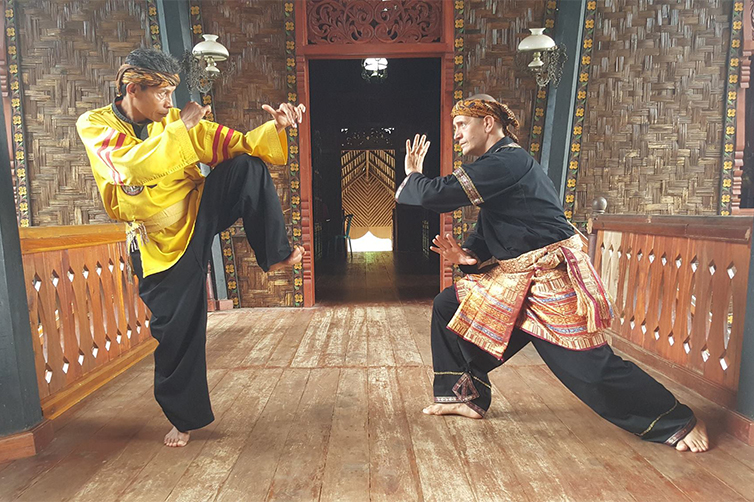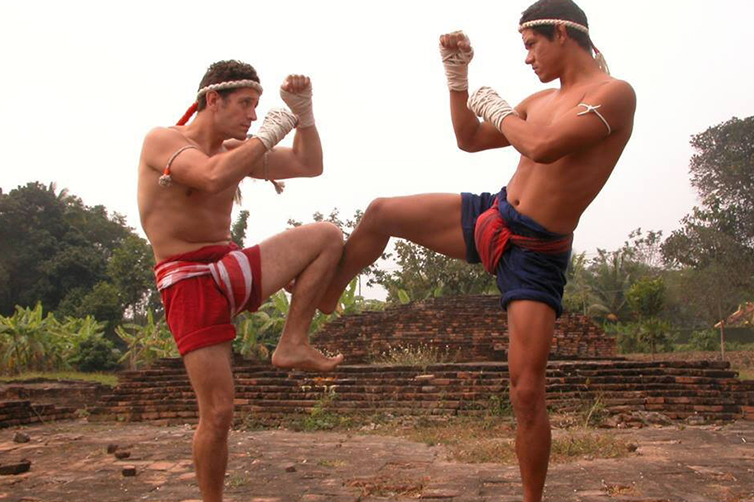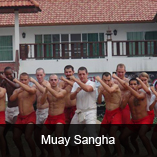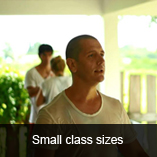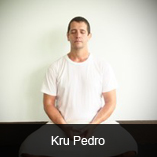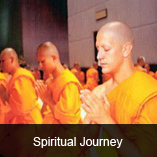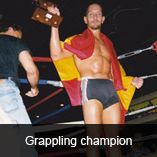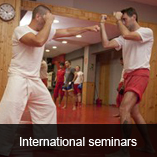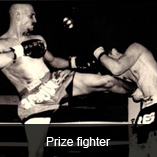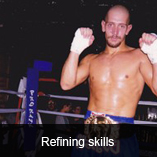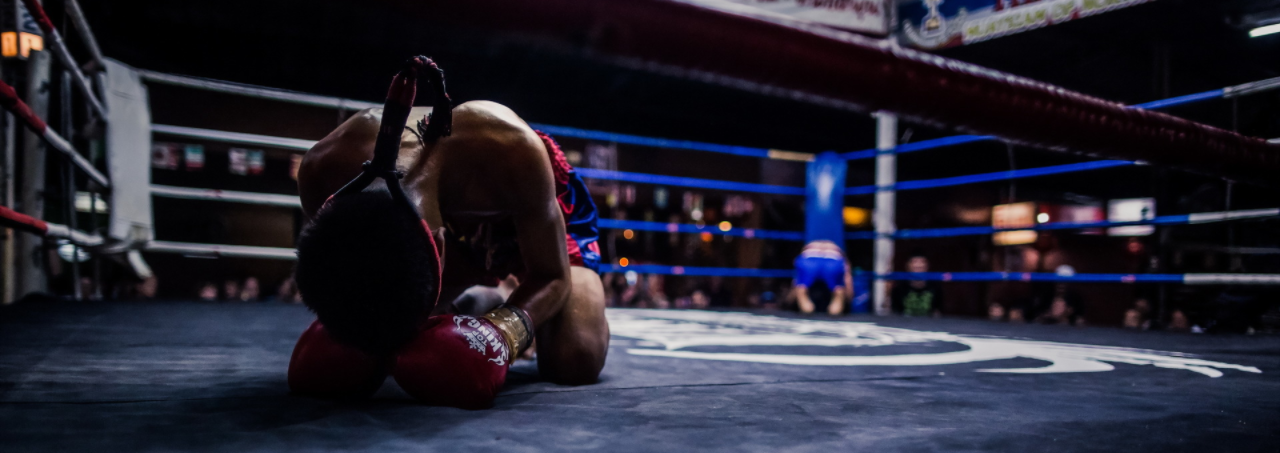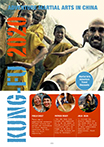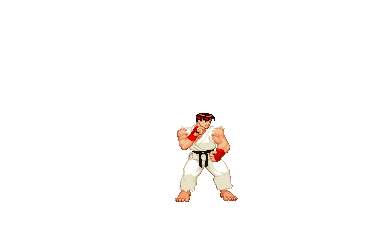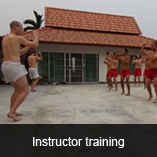
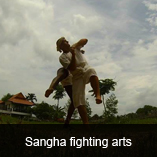
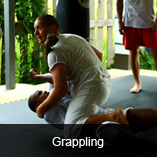
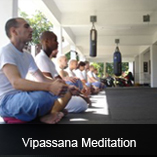
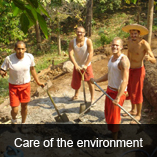 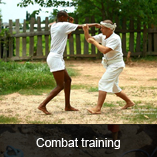 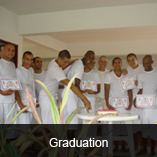 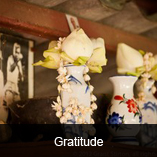 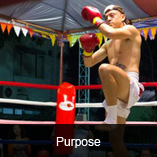 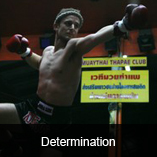 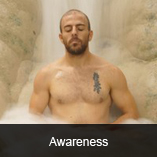 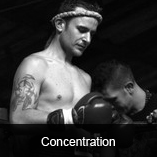 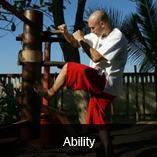  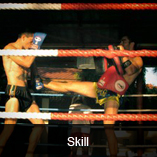  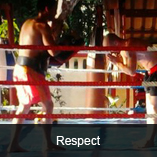 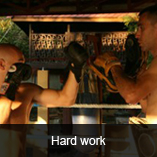 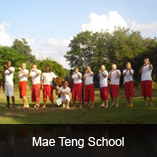 |
| Muay Sangha morning training has a free flowing effect on the mind and is indicated to improve our receptive senses in many different ways and, to develop sensitivity under different amounts of pressure. The morning practice consists of connecting with the life force, how to extend our consciousness to our opponent’s energy field and how to stick and flow with any attack through balance and proper body mechanics. The training is mainly grappling based with different take downs and quick submissions.
Kru Pedro believes in awareness and inner balance and that is why the morning training is designed for. None aggression is taught in training so the mind feels relaxed, present and aware, ready to flow with whatever comes. This training can be easily extended to our daily life by adopting this concept of adaptation into whatever situation we are in.
Kru Pedro encourages mindfulness in training to be able to, be in the present moment, see our feelings and movements from a deeper perspective. This exercise will create an expanded field of energy around us, and as a result will improve our ability to listen to the opponent attack just before it happens.
Evening Training consists of practice in the Muay Thai Sangha Fighting Arts. This kind of training is specially indicated for those who are looking to learn from different Muay Thai, silat and wing chun methods under different concepts of movement. Training first covers evasions and counter attacks following the philosophy of self-defense.
In this school there is a belief that no one should have the right to harm others and we also believe that everyone has the right to defend themselves at all times.
The training covers different training routines to develop good levels of cardiovascular power, speed and agility all by using triangular and circular patterns of movement.
Sparring sessions in the evenings are also emphasized if students wish to reach a good understanding of the distance and develop correct timing.
In the school training combines the two completely opposite methods of training (sensitivity and awareness in the morning and strength and power in the evening). The view is that this makes for more complete results.
A Typical Training Day
After vipassana meditation and breakfast, the Muay Thai Sangha Internal Arts training (Chikun and Grappling) starts around 8:00 am and last until 10:30 am. After training students do some communal work for about half an hour (cleaning, watering the plants, feeding the horses or whatever is needed) then we have lunch and rest until the evening practice.
In the early evening, after tea, Muay Thai Sangha Fighting Arts (Muay Thai, Muay Chaiya, Wing Chun and Silat) training will starts at 4:00 pm until 6:30 pm. After training, students have dinner at a local restaurant.
After dinner, on some students, may watch an interesting movie or talk about selected subjects. At the end of the day, meditation and rest is encouraged until the next morning.
Teaching runs from Monday Morning to Saturday Afternoon. There are no classes on Saturday evenings and Sundays.
The training takes place at the school in Mae Taeng where the students will be staying. Sometimes the morning training is held in the local hot springs, waterfalls or in the Muay Sangha Mountain Camp (depending on weather conditions) located in the near mountains of Mae Taeng.
It is recommended that all the students who wish to come and practice come with an open heart and with a mind empty of ideas or methods as this will ensure the maximum benefit of this experience.
Student who attend this school can expect to learn elements and principles and techniques from the following styles:
Competition Muay Thai, Ancient Muay Thai Chiaya, Bakator, Kalaripayat, Krabi-Kabong, Penack Silat, Taichi prinicples, Wing Chun, Grappling and Vipasanna meditation. These elements make up the Muay Sangha system.
For those with specific training requirements, Kru Pedro can prepare a specially tailored training plan. Muay Thai Sangha training will increase your balance, co-ordination, power, speed and timing. By practicing meditation and qigong, your awareness, concentration and sensitivity will improve further each day. Muay Thai Sangha striking will teach you counter-attacks and defensive techniques from long to medium combat ranges. Muay Thai Sangha grappling combat covers close range fighting, teaching you how to neutralize an aggressor either standing up or on the ground. You'll learn how to keep proper balance while moving and use effective techniques to take the maximum advantage of your own body weight.
THE CORE OF MUAY SANGHA
The approach of the training in the muay Thai sangha school fits that of MMA (mix martial arts). The system emphasizes the correct position of the center of gravity and good body-weight distribution to achieve proper balance. The hands and forearms are placed one on top of the other rotating forwards or backwards in a triangle position according to the body structure. The lower part of the body (knees and feet) move always aware and protecting the center line in 10 different directions.
Muay Thai sangha most dangerous weapons are the counter techniques, blocks with knees and elbows, and fast footwork to evade an attack which mirrors the philosophy of self defence behind the style. All our training, including the sparring, is done with almost no pad protection (groin, mouthpiece and sometimes small gloves). The muay Thai sangha striking uses tricks mainly from many ancient muay Thai styles and a variety of other South-East Asian martial arts.
Muay Thai sangha fighters are well known for their stamina and endurance because the style was created under the concept of conservation and correct use of energy. This is a result from using a holographic sphere related to the three rotations or dimensions of movement. Through careful body position, energy flows into the opponents body creating an overwhelming result on each attack. The result when you drive the energy correctly is a combination of machine blows with a devastating effect. Joints and soft parts of the body are the main targets of muay Thai Sangha.
It must be emphasized that we are not limited by the rules of sport muay Thai, that means we also train real self-defence. Attacks to the groin, throat and eyes are often part of our training. Also all kinds of throws, sweeps and ground-fighting are taught.
Here is a quick description of the kinds of training that we offer in the school:
Striking Muay Sangha Training
The striking is done with all the limbs of the body. In every attack, fake, counter-attack, or evasion, the body should be in balance with the center of gravity firmly in the middle of the body. Muay Thai Sangha doesn’t place emphasis on using muscular power rather tendon strength and the whole body weight on each movement. Muay Thai Sangha uses a total 108 standing up counter attack techniques.
Also muay Thai sangha contains a number of offensive moves for each body weapon as well as a number of yang sam khum footwork exercises to develop good mobility. The offensive skills taught only after the student can properly defend himself.
The source of the Muay Sangha striking system includes not only Muay Thai and Muay Chaiya from Thailand but from all around South-East Asia - Bokator from Cambodia, Silat from Indonesia, Kalaripayattu from India and Wing Chun and Taiji from China, all as a way to reinforce the weakness of a single style training.
Grappling Muay SanghaTraining
Grappling is the other main element in the Muay Thai sangha system. In this element we learn how to deal with grappling encounters in different situations. The styles that we use in our training are based on judo, wrestling, shooto, Brazilian jiu-jitsu and silat. The training covers three different areas:
Stand Up Grappling
Stand up grappling or clinching addresses the issue of fighting at close range. The training is based on defensive and offensive situations whilst in the standing position.Our standing grappling allows striking between movements and quick take down-submissions on the ground to get to our feet as fast as possible.
Our grappling curriculum doesn't emphasize techniques that only use strength but how to use the opponent's energy through proper body rotation and timing. The student will learn how to submit a stand up opponent, how to get to his back, take him down or to escape from any lock or dangerous position. We train in stand up grappling about 80% of the time, and ground fighting about 20%.
Half Standing Half Ground
This method of fighting applies to situations when we fall to the ground while our opponent is standing up.This type of training gives us skills on how to defend ourselves from any standing up attack while we are kneeling, sitting or lying down on the ground. Take downs and counter attacks from the ground are included into the training to give us the option of standing up or bring the opponent down.
Ground Fighting
Ground Fighting addresses the issue of fighting an opponent at close range on the ground. Students learn the basic ground positions, submission holds and defences while rolling on the ground.
Muay Thai sangha supports the idea that when we are fighting on the ground, we are exposed and extremely vulnerable because a lack of vision behind us. To minimize this risk we teach quick submissions and our main goal in a fight situation is to stand up as fast as we can. This is the reason why students only train ground fighting around 20% of the time.
The techniques used in the ground are mainly based on Brazilian Jiu-Jitsu, Shoot Wresting, Judo and American Wrestling but also come from Indonesian Silat and Cambodian Bokator. All these styles have been incorporated to muay Thai sangha so the system continues developing.
Internal or Mental Muay Sangha Training
Muay Sangha Internal or Mental training focuses on a dynamic and balanced awareness of one's own and their opponent's body mechanics, movements, and energy. Developing the ability to fight without fighting and defend with confidence without harming. The principals of Muay Sangha can be applied to the fighting arts seamlessly. However, the internal curriculum is designed to truly master one's own mind, body and energy so we can learn to conquer the fear that drives us to fight and embrace the peace and connection to energy that empowers us to choose not to harm.
The Muay Sangha Internal program of study is ever-evolving (as Kru believes so the human mind is) and has many integral elements. These include developing students' balance through emphasis on harmony with the earth's gravity and correct structural alignment of the body so that the skeletal structure, muscles, and related nerves work in consonance to form a healthy and consistent whole. In addition, Muay Sangha Internal Arts' concept of body mechanics applies kinesiology to the use of proper body movement in practice to enhance coordination and endurance while expanding awareness of opponents' body mechanics. These concepts are accentuated by three rotational axes of movement: lateral, horizontal and vertical. Translation of the body's kinetic energy into effortless motion along with vibrational awareness -- consciousness of energetic frequencies that cannot be seen by the human eye -- are other fundamental concepts intrinsic to Kru's system of martial arts. Together, these concepts lay the foundation for the Muay Sangha Internal training curriculum.
Spiritual or Healing Muay Sangha Training
We believe that serving others is a very important step on the path of self healing.
The spiritual training in the muay sangha school is based on a program of activities related to serving others, this includes releasing fishes and live stock on new moon days, visit local orphanages to make small but often donations on important holidays, cleaning up litter around the nearby mountains and planting trees on full moon days.
Along with this, different types of meditation are practiced after each training session in different locations (waterfalls, jungle, hot springs, caves or lakes) in order to develop concentration and awareness while enjoying the natural surroundings.
INTENSIVE COURSES
The Muay Thai Sangha Arts holds a number of intensive fighting arts courses per year to pass on the curriculum for those who want to experience a truly effective system of fighting. The intensive course curriculum can also allow each student when completed to become a certified teacher recognized by the school.
The intensive courses are divided into three stages: beginner, intermediate, and advanced. The duration of each of these intensive courses will be one full month. All the courses cover 6 hours per day, 5 days per week (Monday-Friday), and 3 hours on Saturday. Each intensive course is split into morning and evening sessions with a break in between.
The beginner and intermediate courses are composed of both Krabong (wooden staff) and Muay Thai training in the morning, and both Muay Chaiya and Thai Double Swords training in the evening. The advanced intensive course curriculum allows the student to choose and specialize in particular topics of either Krabong/Muay Thai or Muay Chaiya/Thai Double Swords for the entire duration of the month. The entire Muay Thai Sangha fighting arts curriculum covers armed and unarmed combat situations from stand-up to ground fighting techniques, both for competition and self-defense purposes.
The Courses are held at our Muay Thai Sangha Headquarters located in the heart of Northern Thailand, only 40 minutes North of Chiang Mai in the village of Mae Taeng, a small town surrounded by mountains next to the Srilanna national park.
The fees for any of the intensive courses include the training, private accommodation and uniform for each student. Meals and other expenses are excluded.
The beginner's course can be completed by either an intensive course or by completing all 4 weekly courses throughout the year. All the courses will be held at the Muay Thai Sangha School, located in Mae Taeng, North of Chiang Mai, Thailand.
|
